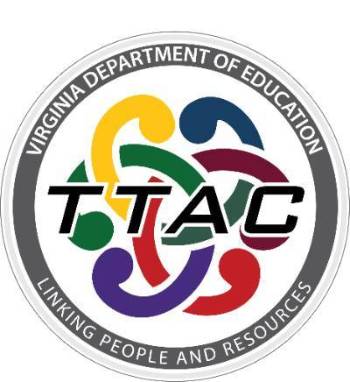Radford University
Virginia Department of Education Training and Technical Assistance Center (TTAC)
Welcome to TTAC at Radford University
The Virginia Department of Education’s state-wide Training and Technical Assistance Centers (TTACs) provide professional development and support designed to assist schools in addressing accountability and improvement goals for students with disabilities.
The VDOE's TTAC at Radford University serves public schools, teachers, students, and parents of Southwest Virginia through assistance that brings about systematic change in the way schools serve children and youth. TTAC services are provided primarily through embedded professional development.
Projects Supporting Inclusive Practices
Visit each of the following Focus Areas and Projects to learn more about inclusive practices we support.
Resources and Information Links
-
TTAC Online

The TTAC Online website was created by VDOE as resource for professionals and family members of children and youth with disabilities (birth to 22). The website offers a wide range of resources, events (training, conferences, and webinars/webcasts) and online training opportunities in the form of Webshops and Workshops.
-
The Virginia Family's Guide to Special Education
This state guide was developed by the Virginia Department of Education (VDOE) in order to help those involved in special education, whether as parents (as defined in this document), teachers or school administrators, advocates, or students. Meeting the needs of children with disabilities requires an understanding of rights and responsibilities which include the child’s rights, and the school’s responsibilities to meet their needs. This guide includes a description of the special education process and what is required during each step of that process.
-
Radford University Teaching Resources Center
Visit the Collections page in the Teaching Resources Center to support and enhance K-12 instruction, teacher education, and assist in the implementation of professional and state standards.
For more information contact trc@radford.edu.
-
Virginia Assistive Technology Network
The Assistive Technology Network of Virginia addresses priorities of VDOE with coordination, implementation, and dissemination of information about the laws which define AT devices and services, the process of AT Consideration by Individualized Education Program (IEP) teams, AT assessment, Augmentative and Augmentative Communication (AAC), and AT resources.
- In support of these priorities, the network has several initiatives which include:
- Developing resources and documents for AT Considerations and Assessment
- Developing and supporting local and regional AT teams with information, resources and training, including the annual Virtual TechKnowledgy Conference
- Integrating AT solutions across the curriculum
School Divisions Served by Radford University Training and Technical Assistance Center
Region 6 Schools |
Region 7 Schools |